北师大版(2019)高中英语必修第三册 Unit8 Green livingLesson 3 "White Bikes" on the Road名师教学设计
文档属性
| 名称 | 北师大版(2019)高中英语必修第三册 Unit8 Green livingLesson 3 "White Bikes" on the Road名师教学设计 |
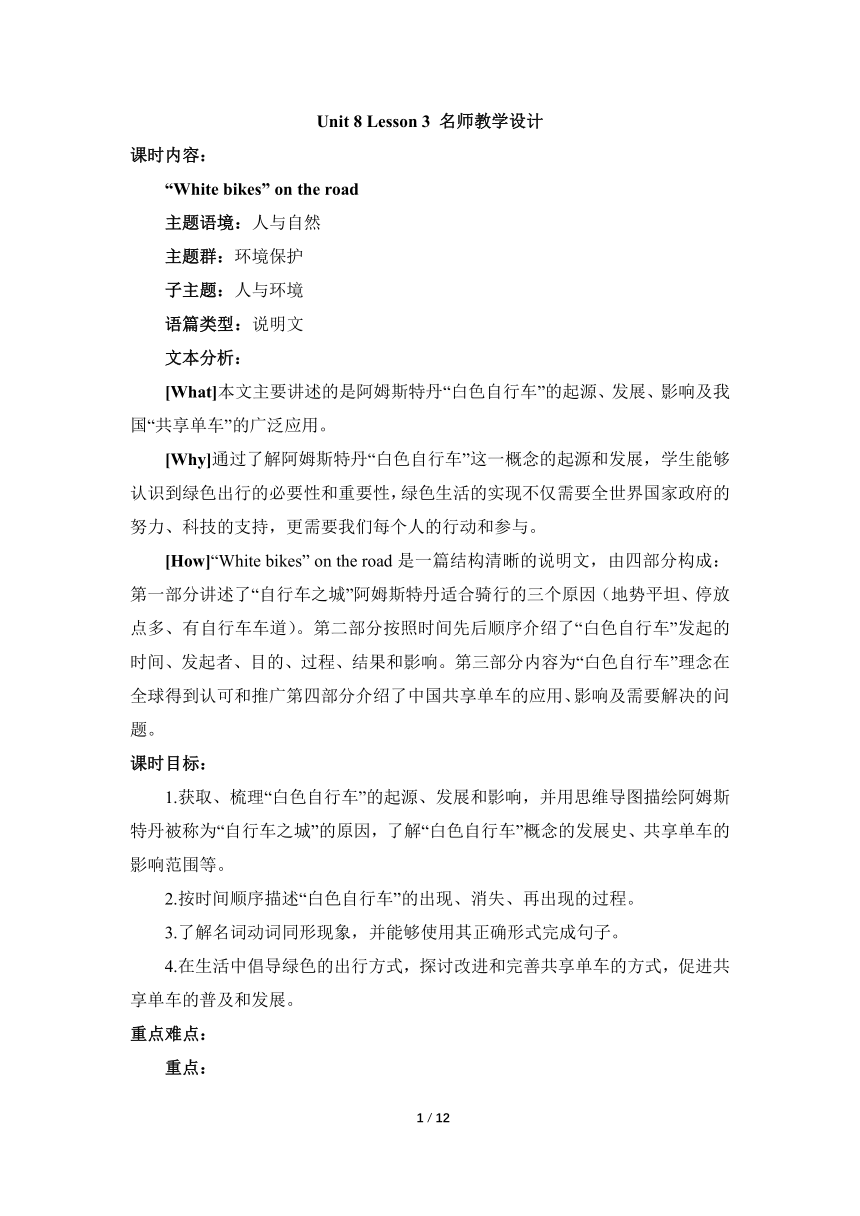
|
|
| 格式 | docx | ||
| 文件大小 | 384.3KB | ||
| 资源类型 | 教案 | ||
| 版本资源 | 北师大版(2019) | ||
| 科目 | 英语 | ||
| 更新时间 | 2023-03-07 21:36:41 | ||
图片预览

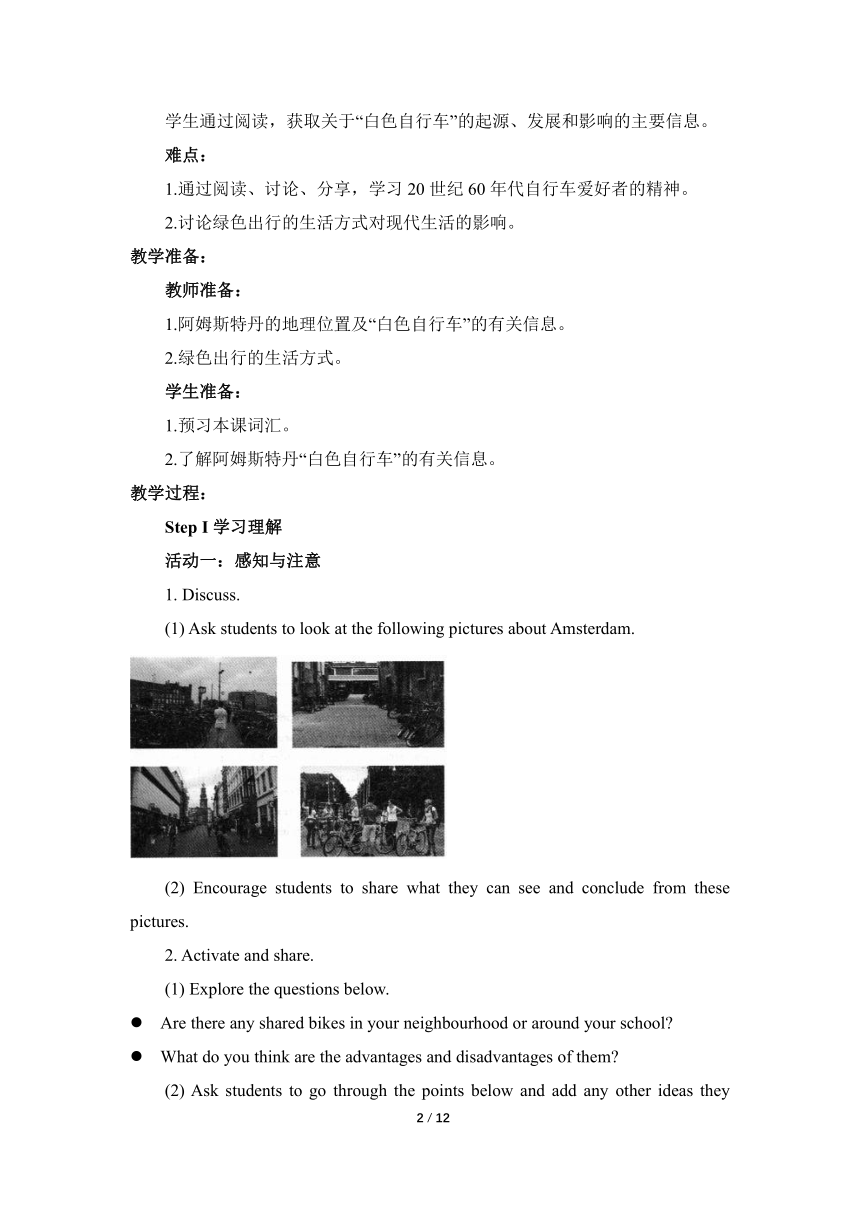
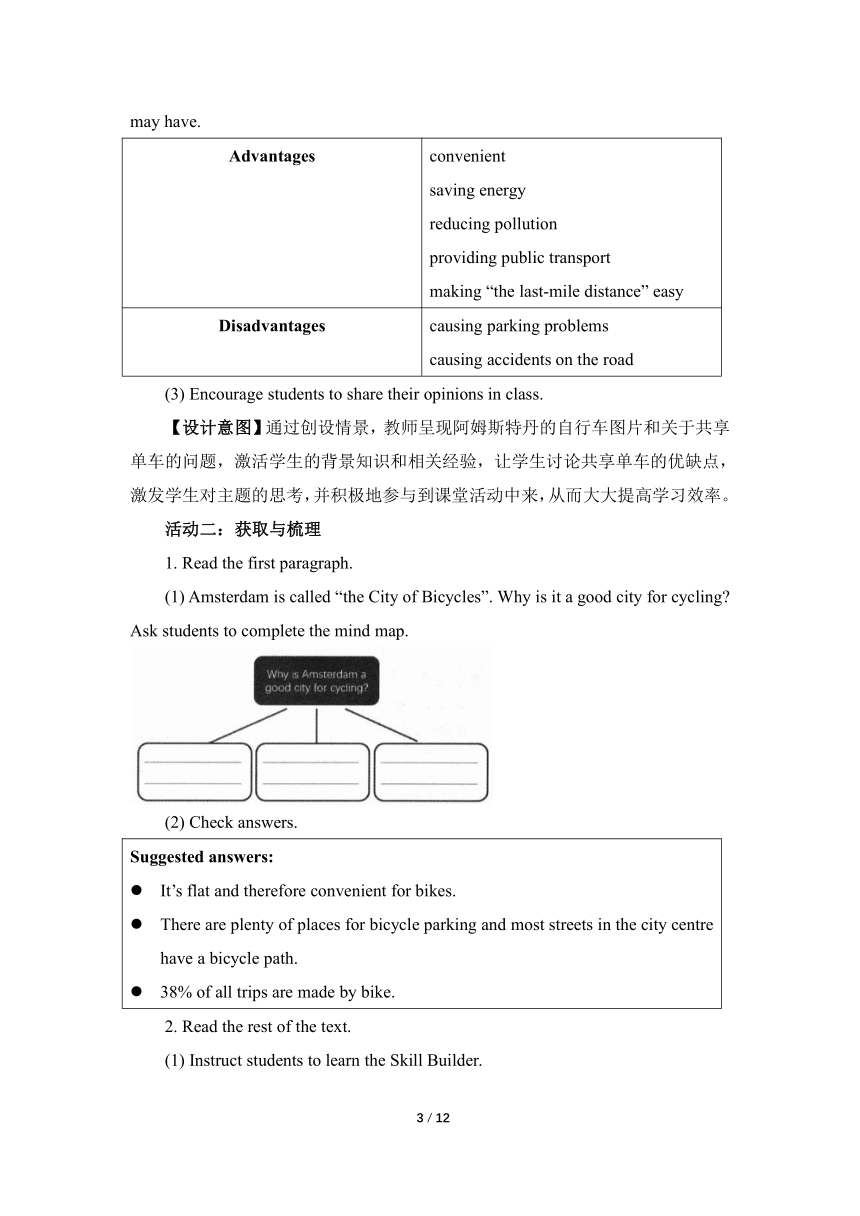
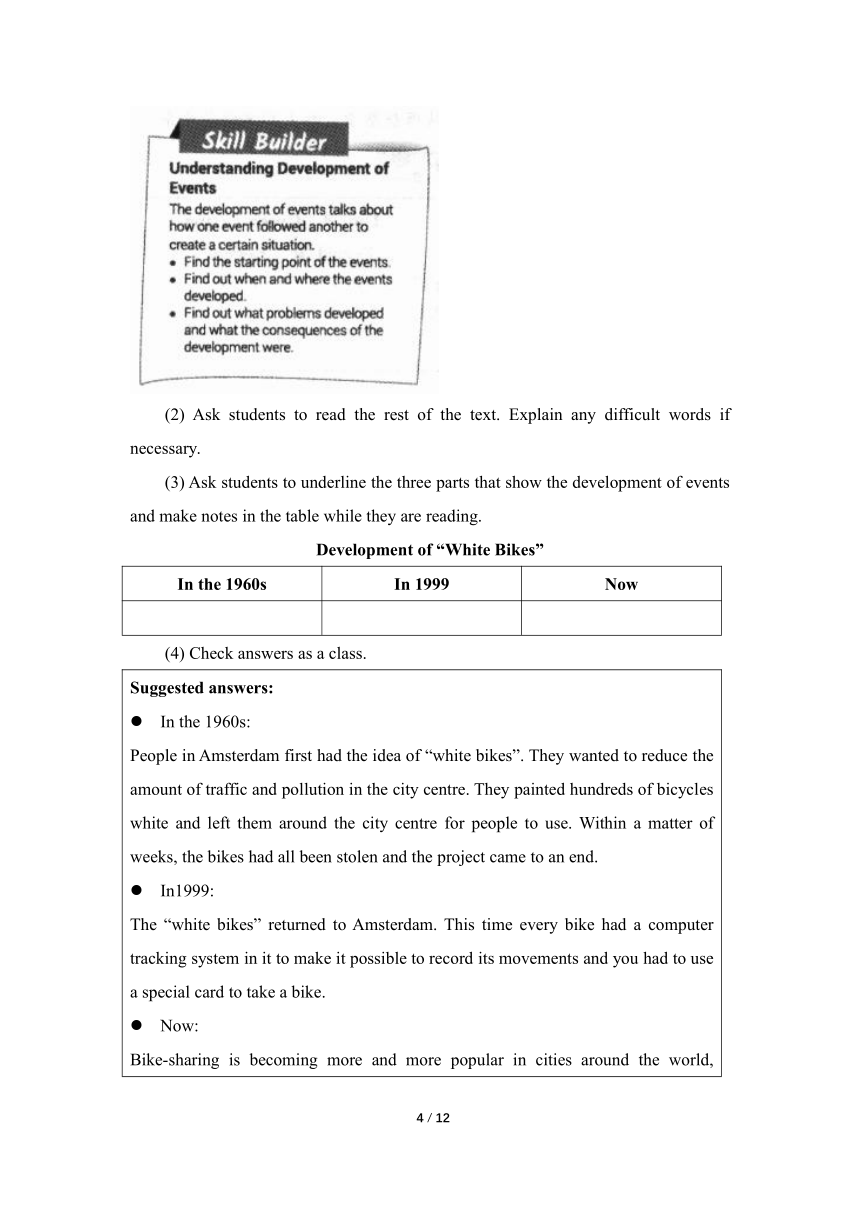
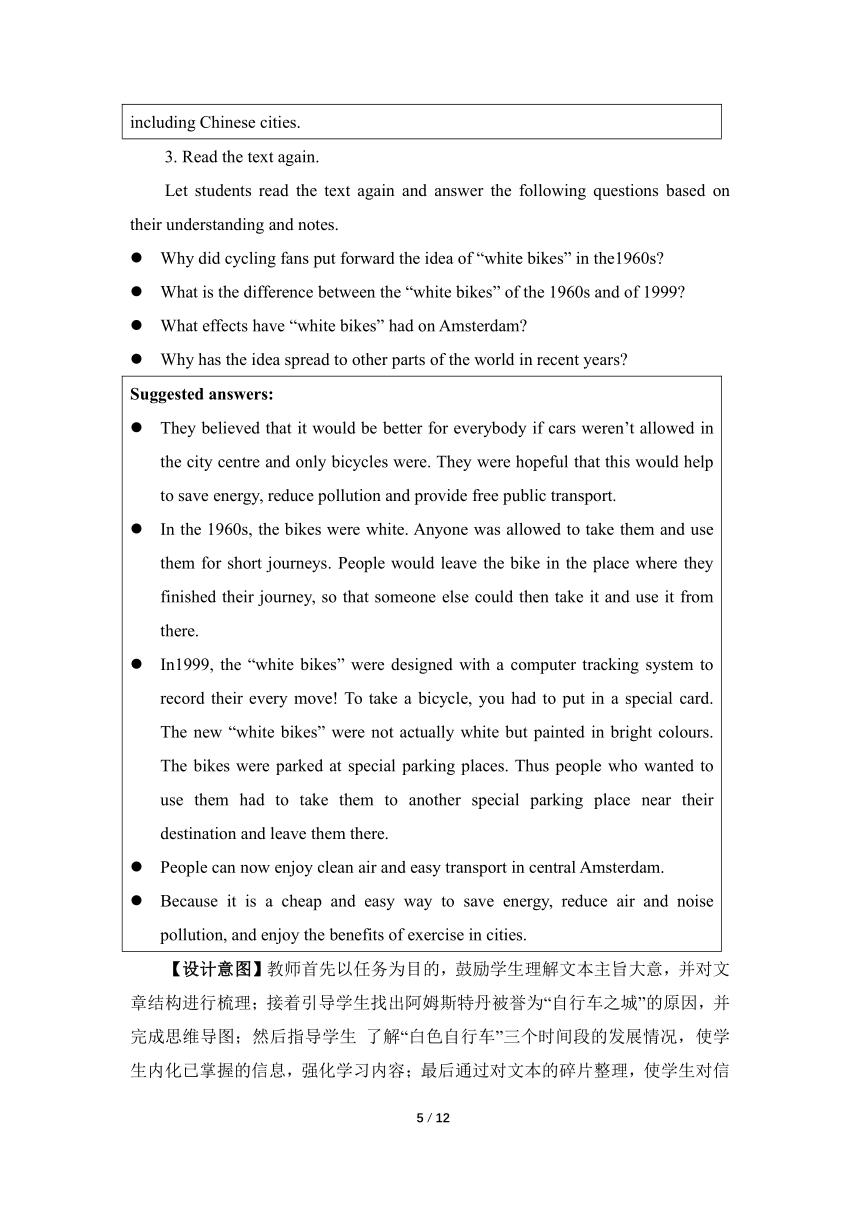
文档简介
Unit 8 Lesson 3 名师教学设计
课时内容:
“White bikes” on the road
主题语境:人与自然
主题群:环境保护
子主题:人与环境
语篇类型:说明文
文本分析:
[What]本文主要讲述的是阿姆斯特丹“白色自行车”的起源、发展、影响及我国“共享单车”的广泛应用。
[Why]通过了解阿姆斯特丹“白色自行车”这一概念的起源和发展,学生能够认识到绿色出行的必要性和重要性,绿色生活的实现不仅需要全世界国家政府的努力、科技的支持,更需要我们每个人的行动和参与。
[How]“White bikes” on the road是一篇结构清晰的说明文,由四部分构成:第一部分讲述了“自行车之城”阿姆斯特丹适合骑行的三个原因(地势平坦、停放点多、有自行车车道)。第二部分按照时间先后顺序介绍了“白色自行车”发起的时间、发起者、目的、过程、结果和影响。第三部分内容为“白色自行车”理念在全球得到认可和推广第四部分介绍了中国共享单车的应用、影响及需要解决的问题。
课时目标:
1.获取、梳理“白色自行车”的起源、发展和影响,并用思维导图描绘阿姆斯特丹被称为“自行车之城”的原因,了解“白色自行车”概念的发展史、共享单车的影响范围等。
2.按时间顺序描述“白色自行车”的出现、消失、再出现的过程。
3.了解名词动词同形现象,并能够使用其正确形式完成句子。
4.在生活中倡导绿色的出行方式,探讨改进和完善共享单车的方式,促进共享单车的普及和发展。
重点难点:
重点:
学生通过阅读,获取关于“白色自行车”的起源、发展和影响的主要信息。
难点:
1.通过阅读、讨论、分享,学习20世纪60年代自行车爱好者的精神。
2.讨论绿色出行的生活方式对现代生活的影响。
教学准备:
教师准备:
1.阿姆斯特丹的地理位置及“白色自行车”的有关信息。
2.绿色出行的生活方式。
学生准备:
1.预习本课词汇。
2.了解阿姆斯特丹“白色自行车”的有关信息。
教学过程:
Step I学习理解
活动一:感知与注意
1. Discuss.
(1) Ask students to look at the following pictures about Amsterdam.
(2) Encourage students to share what they can see and conclude from these pictures.
2. Activate and share.
(1) Explore the questions below.
Are there any shared bikes in your neighbourhood or around your school
What do you think are the advantages and disadvantages of them
(2) Ask students to go through the points below and add any other ideas they may have.
Advantages convenient saving energy reducing pollution providing public transport making “the last-mile distance” easy
Disadvantages causing parking problems causing accidents on the road
(3) Encourage students to share their opinions in class.
【设计意图】通过创设情景,教师呈现阿姆斯特丹的自行车图片和关于共享单车的问题,激活学生的背景知识和相关经验,让学生讨论共享单车的优缺点,激发学生对主题的思考,并积极地参与到课堂活动中来,从而大大提高学习效率。
活动二:获取与梳理
1. Read the first paragraph.
(1) Amsterdam is called “the City of Bicycles”. Why is it a good city for cycling Ask students to complete the mind map.
(2) Check answers.
Suggested answers: It’s flat and therefore convenient for bikes. There are plenty of places for bicycle parking and most streets in the city centre have a bicycle path. 38% of all trips are made by bike.
2. Read the rest of the text.
(1) Instruct students to learn the Skill Builder.
(2) Ask students to read the rest of the text. Explain any difficult words if necessary.
(3) Ask students to underline the three parts that show the development of events and make notes in the table while they are reading.
Development of “White Bikes”
In the 1960s In 1999 Now
(4) Check answers as a class.
Suggested answers: In the 1960s: People in Amsterdam first had the idea of “white bikes”. They wanted to reduce the amount of traffic and pollution in the city centre. They painted hundreds of bicycles white and left them around the city centre for people to use. Within a matter of weeks, the bikes had all been stolen and the project came to an end. In1999: The “white bikes” returned to Amsterdam. This time every bike had a computer tracking system in it to make it possible to record its movements and you had to use a special card to take a bike. Now: Bike-sharing is becoming more and more popular in cities around the world, including Chinese cities.
3. Read the text again.
Let students read the text again and answer the following questions based on their understanding and notes.
Why did cycling fans put forward the idea of “white bikes” in the1960s
What is the difference between the “white bikes” of the 1960s and of 1999
What effects have “white bikes” had on Amsterdam
Why has the idea spread to other parts of the world in recent years
Suggested answers: They believed that it would be better for everybody if cars weren’t allowed in the city centre and only bicycles were. They were hopeful that this would help to save energy, reduce pollution and provide free public transport. In the 1960s, the bikes were white. Anyone was allowed to take them and use them for short journeys. People would leave the bike in the place where they finished their journey, so that someone else could then take it and use it from there. In1999, the “white bikes” were designed with a computer tracking system to record their every move! To take a bicycle, you had to put in a special card. The new “white bikes” were not actually white but painted in bright colours. The bikes were parked at special parking places. Thus people who wanted to use them had to take them to another special parking place near their destination and leave them there. People can now enjoy clean air and easy transport in central Amsterdam. Because it is a cheap and easy way to save energy, reduce air and noise pollution, and enjoy the benefits of exercise in cities.
【设计意图】教师首先以任务为目的,鼓励学生理解文本主旨大意,并对文章结构进行梳理;接着引导学生找出阿姆斯特丹被誉为“自行车之城”的原因,并完成思维导图;然后指导学生 了解“白色自行车”三个时间段的发展情况,使学生内化已掌握的信息,强化学习内容;最后通过对文本的碎片整理,使学生对信息的瞬间记忆转为长期记忆。
活动三:概括与整合
Ask students to share the feelings of reading by answering the following question.
Have you found anything you feel excited,interested and inspired
【设计意图】学生在概括,整合已获信息后,形成新的知识结构,感知并理解语言所表达的意义,学习自行车爱好者们不怕困难,勇往直前的精神,并树立环保意识。
Step Ⅱ 应用实践
活动四:描述与阐释
1. Ask students to introduce “white bikes” in Amsterdam with the help of the flow chart.
2. Encourage volunteers to make their presentations in front of the class.
活动五:内化与应用
1. Complete the summary with the information that has been learnt.
People in Amsterdam have been ________ cycling for years. They are particularly lucky because the city is very flat and therefore ________ cycling. Back in the 1960s, a group of cycling fans ________ an idea of using free shared bikes. They believed that this would help to ________, ________ and ________. However, shortly after setting up the new system, there was a serious problem as all the bikes ________. In 1999, the bike-sharing idea returned to Amsterdam. This time they were ________ a computer ________. ________ the efforts of many people, the idea of “shared bikes” has now pedalled its way around the world.
Suggested answers: enjoying the benefits of convenient for came up with save energy reduce pollution provide free public transport disappeared designed with Tracking system Thanks to
2. Learn word builder.
(1) Compare the two sentences in each pair. Decide what the word in bold expresses.
a the name of an object/a thing
b an action to do thing
Suggested answers: b; a ②a; b ③b; a ④b; a
(2) Add other pairs of words similar to the words above.
Suggested answers: transport; use; design; fall; shelter; ride; block; cover; trap; blow; wonder; rescue; experience; judge; pack; base; command; guide; work; reward dislike; matter; concern; change; escape
3. Complete the sentences with the correct form of the words in the Word builder above.
Jason ________ down the road to his school. She put her foot down on the ________. The house will look bright with white ________. The old man asked, “Who ________ all these on my wall ” You should wash your cup and ________ it on the table. This is a great ________ for a holiday I try to keep a ________ of everything I spend. Her mum made her ________ every penny she spent.
Suggested answers: pedals/ pedalled; pedal paint; painted place; place record; record
【设计意图】在学习理解的基础上,教师首先引导学生借助思维导图描述“白色自行车”的起源和发展过程;接着完成本课的内容概要;然后引导学生关注名词动词同形现象,并在语境中判断该选什么词,能用词汇的正确形式完成练习,达到掌握英语单词词性、灵活运用单词的目的,逐步实现对语言知识的内化,促进语言运用的自动化。
Step Ⅲ 迁移创新
活动六:推理与论证
1. Ask students to work in groups and answer the questions.
What does the title “‘White bikes’ on the road” mean
What does the writer mean by saying “Where will bike-sharing go in China You decide.”
2. Discuss the answers as a class.
Suggested answers: “White bikes” on the road refers to “white bikes” being used to ride around the streets of a city. Apart from the literal meaning, the title can also mean that the effort to implement “white bikes” projects takes time and it’s still on the way. There are still aspects that need to be improved. Young people will determine how successful bike-sharing is in the future by deciding whether or not and how much they want to use it. It can also mean that whether or not bike-sharing can exist successfully depends on each individual. Everyone has to take the responsibility to take care of bike-sharing so that it can last longer and help people better.
【设计意图】通过探讨标题和文章最后一句话的意思,引导学生思考文章的深层含义,对语篇背后的价值取向进行推理和论证,探讨语篇与主题意义的关联,使学生能感受字里行间透露出的内在信息,领悟自己的社会责任,感悟到“共享单车”的未来取决于我们每一个人。
活动七:批评与评价
赏析文本的语言特点和修辞手法。
(1)逻辑连接词
because, because of, therefore, thus, however, thanks to, fortunately…
(2)时间副词
soon after, nowadays, 50 years ago…
【设计意图】作者在文中运用了大量的连接词和时间副词来呈现事件发展的逻辑关系与内容结构。
(3)被动句
The idea began about 50 years ago, and was first known as “white bikes”.
…an amazing 38% of all trips are made by bike.
…if cars weren’t allowed in the city centre and only bicycles were.
Anyone was allowed to take them and use them for short journeys.
The new “white bikes” were not actually white but painted in bright colours. The bikes were parked at special parking places.
【设计意图】句式丰富,用客观易懂的方式解释“白色自行车”改良前后的情况与使用方法。
(4)设问
Where did the idea of “white bikes” come from
【设计意图】介绍阿姆斯特丹适于骑行的环境并引出主题“白色自行车”,引发读者好奇,逐步介绍“白色自行车”起源与发展的情况。
Where will bike-sharing go in China You decide.
【设计意图】教师引发学生思考文章的深层含义,领会作者的写作意图和自己的社会责任,理解共享单车的未来取决于每一个人。
活动八:想象与创造
1. Express yourself.
(1) Ask students to look at the two pictures and discuss them.
▲“white bikes” in Amsterdam
▲ shared bikes in China
(2) Ask students to answer the question.
What are the similarities and differences between “white bikes” in Amsterdam and shared bikes in your city/town
Suggested answers: Similarities: People use them for short journeys. There’s a computer tracking system to record their every move. They’re painted in bright colour. Differences: Amsterdam Free public transport. People have to put in a special card to use them. They are parked at special parking places. … China People pay to use them. People download APPs to use them. They are left in the place where users complete their Journeys. …
2. Encourage students to figure out the problems, like the theft of bikes and parking issues to help bike-sharing go smoothly in China.
【设计意图】首先比较阿姆斯特丹“白色自行车”和中国“共享单车”的异同,借鉴“白色自行车”的发展,总结影响共享单车发展的因素,深化所学知识,并拓展到实际生活,从不同角度提出共享单车良性发展的建议。
板书设计:
Unit 8 Green Living Period IV Lesson 3 I.学习理解 活动一:感知与注意 1. Discuss. 2. Activate and share. 活动二:获取与梳理 活动三:概括与整合 II.应用实践 活动四:描述与阐释 活动五:内化与应用 Ⅲ.迁移创新 活动六:推理与论证 活动七:批评与评价 活动八:想象与创造
2 / 2
课时内容:
“White bikes” on the road
主题语境:人与自然
主题群:环境保护
子主题:人与环境
语篇类型:说明文
文本分析:
[What]本文主要讲述的是阿姆斯特丹“白色自行车”的起源、发展、影响及我国“共享单车”的广泛应用。
[Why]通过了解阿姆斯特丹“白色自行车”这一概念的起源和发展,学生能够认识到绿色出行的必要性和重要性,绿色生活的实现不仅需要全世界国家政府的努力、科技的支持,更需要我们每个人的行动和参与。
[How]“White bikes” on the road是一篇结构清晰的说明文,由四部分构成:第一部分讲述了“自行车之城”阿姆斯特丹适合骑行的三个原因(地势平坦、停放点多、有自行车车道)。第二部分按照时间先后顺序介绍了“白色自行车”发起的时间、发起者、目的、过程、结果和影响。第三部分内容为“白色自行车”理念在全球得到认可和推广第四部分介绍了中国共享单车的应用、影响及需要解决的问题。
课时目标:
1.获取、梳理“白色自行车”的起源、发展和影响,并用思维导图描绘阿姆斯特丹被称为“自行车之城”的原因,了解“白色自行车”概念的发展史、共享单车的影响范围等。
2.按时间顺序描述“白色自行车”的出现、消失、再出现的过程。
3.了解名词动词同形现象,并能够使用其正确形式完成句子。
4.在生活中倡导绿色的出行方式,探讨改进和完善共享单车的方式,促进共享单车的普及和发展。
重点难点:
重点:
学生通过阅读,获取关于“白色自行车”的起源、发展和影响的主要信息。
难点:
1.通过阅读、讨论、分享,学习20世纪60年代自行车爱好者的精神。
2.讨论绿色出行的生活方式对现代生活的影响。
教学准备:
教师准备:
1.阿姆斯特丹的地理位置及“白色自行车”的有关信息。
2.绿色出行的生活方式。
学生准备:
1.预习本课词汇。
2.了解阿姆斯特丹“白色自行车”的有关信息。
教学过程:
Step I学习理解
活动一:感知与注意
1. Discuss.
(1) Ask students to look at the following pictures about Amsterdam.
(2) Encourage students to share what they can see and conclude from these pictures.
2. Activate and share.
(1) Explore the questions below.
Are there any shared bikes in your neighbourhood or around your school
What do you think are the advantages and disadvantages of them
(2) Ask students to go through the points below and add any other ideas they may have.
Advantages convenient saving energy reducing pollution providing public transport making “the last-mile distance” easy
Disadvantages causing parking problems causing accidents on the road
(3) Encourage students to share their opinions in class.
【设计意图】通过创设情景,教师呈现阿姆斯特丹的自行车图片和关于共享单车的问题,激活学生的背景知识和相关经验,让学生讨论共享单车的优缺点,激发学生对主题的思考,并积极地参与到课堂活动中来,从而大大提高学习效率。
活动二:获取与梳理
1. Read the first paragraph.
(1) Amsterdam is called “the City of Bicycles”. Why is it a good city for cycling Ask students to complete the mind map.
(2) Check answers.
Suggested answers: It’s flat and therefore convenient for bikes. There are plenty of places for bicycle parking and most streets in the city centre have a bicycle path. 38% of all trips are made by bike.
2. Read the rest of the text.
(1) Instruct students to learn the Skill Builder.
(2) Ask students to read the rest of the text. Explain any difficult words if necessary.
(3) Ask students to underline the three parts that show the development of events and make notes in the table while they are reading.
Development of “White Bikes”
In the 1960s In 1999 Now
(4) Check answers as a class.
Suggested answers: In the 1960s: People in Amsterdam first had the idea of “white bikes”. They wanted to reduce the amount of traffic and pollution in the city centre. They painted hundreds of bicycles white and left them around the city centre for people to use. Within a matter of weeks, the bikes had all been stolen and the project came to an end. In1999: The “white bikes” returned to Amsterdam. This time every bike had a computer tracking system in it to make it possible to record its movements and you had to use a special card to take a bike. Now: Bike-sharing is becoming more and more popular in cities around the world, including Chinese cities.
3. Read the text again.
Let students read the text again and answer the following questions based on their understanding and notes.
Why did cycling fans put forward the idea of “white bikes” in the1960s
What is the difference between the “white bikes” of the 1960s and of 1999
What effects have “white bikes” had on Amsterdam
Why has the idea spread to other parts of the world in recent years
Suggested answers: They believed that it would be better for everybody if cars weren’t allowed in the city centre and only bicycles were. They were hopeful that this would help to save energy, reduce pollution and provide free public transport. In the 1960s, the bikes were white. Anyone was allowed to take them and use them for short journeys. People would leave the bike in the place where they finished their journey, so that someone else could then take it and use it from there. In1999, the “white bikes” were designed with a computer tracking system to record their every move! To take a bicycle, you had to put in a special card. The new “white bikes” were not actually white but painted in bright colours. The bikes were parked at special parking places. Thus people who wanted to use them had to take them to another special parking place near their destination and leave them there. People can now enjoy clean air and easy transport in central Amsterdam. Because it is a cheap and easy way to save energy, reduce air and noise pollution, and enjoy the benefits of exercise in cities.
【设计意图】教师首先以任务为目的,鼓励学生理解文本主旨大意,并对文章结构进行梳理;接着引导学生找出阿姆斯特丹被誉为“自行车之城”的原因,并完成思维导图;然后指导学生 了解“白色自行车”三个时间段的发展情况,使学生内化已掌握的信息,强化学习内容;最后通过对文本的碎片整理,使学生对信息的瞬间记忆转为长期记忆。
活动三:概括与整合
Ask students to share the feelings of reading by answering the following question.
Have you found anything you feel excited,interested and inspired
【设计意图】学生在概括,整合已获信息后,形成新的知识结构,感知并理解语言所表达的意义,学习自行车爱好者们不怕困难,勇往直前的精神,并树立环保意识。
Step Ⅱ 应用实践
活动四:描述与阐释
1. Ask students to introduce “white bikes” in Amsterdam with the help of the flow chart.
2. Encourage volunteers to make their presentations in front of the class.
活动五:内化与应用
1. Complete the summary with the information that has been learnt.
People in Amsterdam have been ________ cycling for years. They are particularly lucky because the city is very flat and therefore ________ cycling. Back in the 1960s, a group of cycling fans ________ an idea of using free shared bikes. They believed that this would help to ________, ________ and ________. However, shortly after setting up the new system, there was a serious problem as all the bikes ________. In 1999, the bike-sharing idea returned to Amsterdam. This time they were ________ a computer ________. ________ the efforts of many people, the idea of “shared bikes” has now pedalled its way around the world.
Suggested answers: enjoying the benefits of convenient for came up with save energy reduce pollution provide free public transport disappeared designed with Tracking system Thanks to
2. Learn word builder.
(1) Compare the two sentences in each pair. Decide what the word in bold expresses.
a the name of an object/a thing
b an action to do thing
Suggested answers: b; a ②a; b ③b; a ④b; a
(2) Add other pairs of words similar to the words above.
Suggested answers: transport; use; design; fall; shelter; ride; block; cover; trap; blow; wonder; rescue; experience; judge; pack; base; command; guide; work; reward dislike; matter; concern; change; escape
3. Complete the sentences with the correct form of the words in the Word builder above.
Jason ________ down the road to his school. She put her foot down on the ________. The house will look bright with white ________. The old man asked, “Who ________ all these on my wall ” You should wash your cup and ________ it on the table. This is a great ________ for a holiday I try to keep a ________ of everything I spend. Her mum made her ________ every penny she spent.
Suggested answers: pedals/ pedalled; pedal paint; painted place; place record; record
【设计意图】在学习理解的基础上,教师首先引导学生借助思维导图描述“白色自行车”的起源和发展过程;接着完成本课的内容概要;然后引导学生关注名词动词同形现象,并在语境中判断该选什么词,能用词汇的正确形式完成练习,达到掌握英语单词词性、灵活运用单词的目的,逐步实现对语言知识的内化,促进语言运用的自动化。
Step Ⅲ 迁移创新
活动六:推理与论证
1. Ask students to work in groups and answer the questions.
What does the title “‘White bikes’ on the road” mean
What does the writer mean by saying “Where will bike-sharing go in China You decide.”
2. Discuss the answers as a class.
Suggested answers: “White bikes” on the road refers to “white bikes” being used to ride around the streets of a city. Apart from the literal meaning, the title can also mean that the effort to implement “white bikes” projects takes time and it’s still on the way. There are still aspects that need to be improved. Young people will determine how successful bike-sharing is in the future by deciding whether or not and how much they want to use it. It can also mean that whether or not bike-sharing can exist successfully depends on each individual. Everyone has to take the responsibility to take care of bike-sharing so that it can last longer and help people better.
【设计意图】通过探讨标题和文章最后一句话的意思,引导学生思考文章的深层含义,对语篇背后的价值取向进行推理和论证,探讨语篇与主题意义的关联,使学生能感受字里行间透露出的内在信息,领悟自己的社会责任,感悟到“共享单车”的未来取决于我们每一个人。
活动七:批评与评价
赏析文本的语言特点和修辞手法。
(1)逻辑连接词
because, because of, therefore, thus, however, thanks to, fortunately…
(2)时间副词
soon after, nowadays, 50 years ago…
【设计意图】作者在文中运用了大量的连接词和时间副词来呈现事件发展的逻辑关系与内容结构。
(3)被动句
The idea began about 50 years ago, and was first known as “white bikes”.
…an amazing 38% of all trips are made by bike.
…if cars weren’t allowed in the city centre and only bicycles were.
Anyone was allowed to take them and use them for short journeys.
The new “white bikes” were not actually white but painted in bright colours. The bikes were parked at special parking places.
【设计意图】句式丰富,用客观易懂的方式解释“白色自行车”改良前后的情况与使用方法。
(4)设问
Where did the idea of “white bikes” come from
【设计意图】介绍阿姆斯特丹适于骑行的环境并引出主题“白色自行车”,引发读者好奇,逐步介绍“白色自行车”起源与发展的情况。
Where will bike-sharing go in China You decide.
【设计意图】教师引发学生思考文章的深层含义,领会作者的写作意图和自己的社会责任,理解共享单车的未来取决于每一个人。
活动八:想象与创造
1. Express yourself.
(1) Ask students to look at the two pictures and discuss them.
▲“white bikes” in Amsterdam
▲ shared bikes in China
(2) Ask students to answer the question.
What are the similarities and differences between “white bikes” in Amsterdam and shared bikes in your city/town
Suggested answers: Similarities: People use them for short journeys. There’s a computer tracking system to record their every move. They’re painted in bright colour. Differences: Amsterdam Free public transport. People have to put in a special card to use them. They are parked at special parking places. … China People pay to use them. People download APPs to use them. They are left in the place where users complete their Journeys. …
2. Encourage students to figure out the problems, like the theft of bikes and parking issues to help bike-sharing go smoothly in China.
【设计意图】首先比较阿姆斯特丹“白色自行车”和中国“共享单车”的异同,借鉴“白色自行车”的发展,总结影响共享单车发展的因素,深化所学知识,并拓展到实际生活,从不同角度提出共享单车良性发展的建议。
板书设计:
Unit 8 Green Living Period IV Lesson 3 I.学习理解 活动一:感知与注意 1. Discuss. 2. Activate and share. 活动二:获取与梳理 活动三:概括与整合 II.应用实践 活动四:描述与阐释 活动五:内化与应用 Ⅲ.迁移创新 活动六:推理与论证 活动七:批评与评价 活动八:想象与创造
2 / 2
同课章节目录
- Unit 7 Art
- Lesson 1 Masterpieces
- Lesson 2 Beijing Opera
- Lesson 3 A Musical Genius
- Unit 8 Green living
- Lesson 1 Roots and Shoots
- Lesson 2 Greening the Desert
- Lesson 3 "White Bikes" on the Road
- Unit 9 Learning
- Lesson 1 Active Learning
- Lesson 2 Language Learning Tips
- Lesson 3 The Secrets of Your Memory
